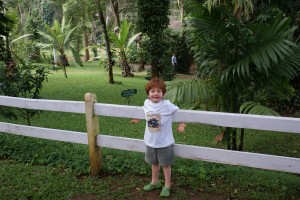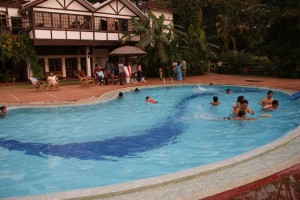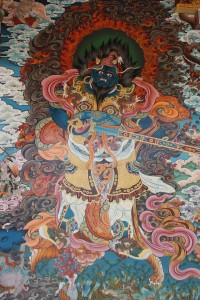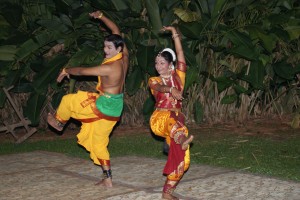Post #15
We moved on to Coorg.
Coorg is a little slice of wonderland in India. It is in the hill country of Karnataka and is a major area for growing coffee and spices.
Coorg was once a separate state with its own rulers and traditions. Its traditions still live on, and we were surprised to find that pork is very popular, very unusual for India and certainly for South India, which is so heavily vegetarian. The region itself is blanketed with coffee estates, with the low bushes and their red berries complemented by tall climbing pepper plants which are grown right alongside. Visually, the place is incredibly beautiful – flowers everywhere, and winding country roads branching off between the many estates. Coorg has been called the Scotland of India and it is easy to understand the parallels.
Many of the coffee estates seem to belong to Tata, the huge Indian conglomerate that seems to be involved in every area of the Indian economy from cars to tea. We also learned that the coffee from Coorg is strongly favoured by Illy, the famous Italian coffee maker whose coffee is found in high end coffeeshops all over the world. The coffee we had in Coorg was incredible, and I am not a big coffee drinker.
We stayed at the Orange County resort tucked away in the hills somewhere. Thatched cottages lent themselves to the Scottish theme, and we spent a couple of days enjoying great food (we don’t eat pork but there were lots of alternatives), swimming in the pool, walking through the plantations and visiting the surrounding countryside, which amazingly enough, is home to one of the largest Tibetan Buddhist monasteries and populations anywhere. This was an excellent place to be, but it was also the biggest splurge by far during our trip in India. There are many simpler guesthouses in the area – this resort clearly directed itself to Bangaloreans who had made it big and a handful of foreigners like us.
Eitan turned four in Coorg, and Raja, our driver, unknown to us, had called ahead and asked the hotel to bake a special birthday cake which was waiting for us when we arrived. This was a typical example of what endeared Raja to the kids – it’s always the small special touches that one remembers, often more so than the major monuments.
There was one other Western family in the hotel. Otherwise it was clearly a favourite amongst local tourists and the kids took part with other Indian kids in activities such as a scavenger hunt, where a whole bunch of kids ran around the hotel gardens for half the afternoon. We learned about coffee growing, and spices in general and our stay was a great break from the hectic itinerary so far.
We visited the Namdroling monastery in Bylekuppe, a hugely ornate golden Buddhist temple that was established by Tibetan refugees. There are many such settlements in North India, but here, far away from Tibet and the mountains, is a large and flourishing population. Buddhist temples are always fascinating for kids, with chanting, drums, and huge trumpets blasting their long droning music. Our kids were amazed by the fact that many of the trainee monks were kids themselves, probably much the same age as themselves. Shaven heads, red robes and a friendly smile are some of the great memories they have of this special place. The restaurants are Tibetan too, so we had momos and other Tibetan food for lunch one day.
The following day we visited Dubare, which is a wildlife sanctuary focused on offering an “elephant experience”. Besides us, there was another family from Germany currently based in Bangalore, and many local families with kids.
The program includes elephants being fed giant brown balls of gunk, and after which they are taken for a bath in the river. Everyone is invited to help wash them, so there we were, wading through mud and elephant poop to wash the huge animals that were lying down very sedately. Maybe not an experience for everybody but all the kids loved it. There were short elephant rides next, and then an elephant “soccer game” which consisted of a few elephants being prodded by their riders with huge metal spikes to kick a ball back and forth. I could have done without this part but it delighted all the kids watching.

An elephant seems to have taken a liking to the kids!
In the evening the hotel put on an excellent show of local traditional dance. Two dancers, a man and a woman, acted out a famous local legend in music and dance and with free local estate coffee on offer, it was a fine way to end a day.
Something that we were very impressed by were the bags that the hotel gave to guests, made of recycled newspapers that were made in a local co-operative. It was such a clever and environmentally friendly idea that I wished I could see more of those around.
Coorg is a highlight of Southern India, but remains well off the (foreign) tourist path. Tata seems to be developing guest houses on their estates, and with their backing, it probably is simply a matter of time before Coorg will find its way onto the beaten track. For the meantime, it offers an authentic, fully child friendly experience that mainly locals seem to be enjoying.
PS These days I’m planning great family trips to India. For more info on how I can help your family, visit here.




